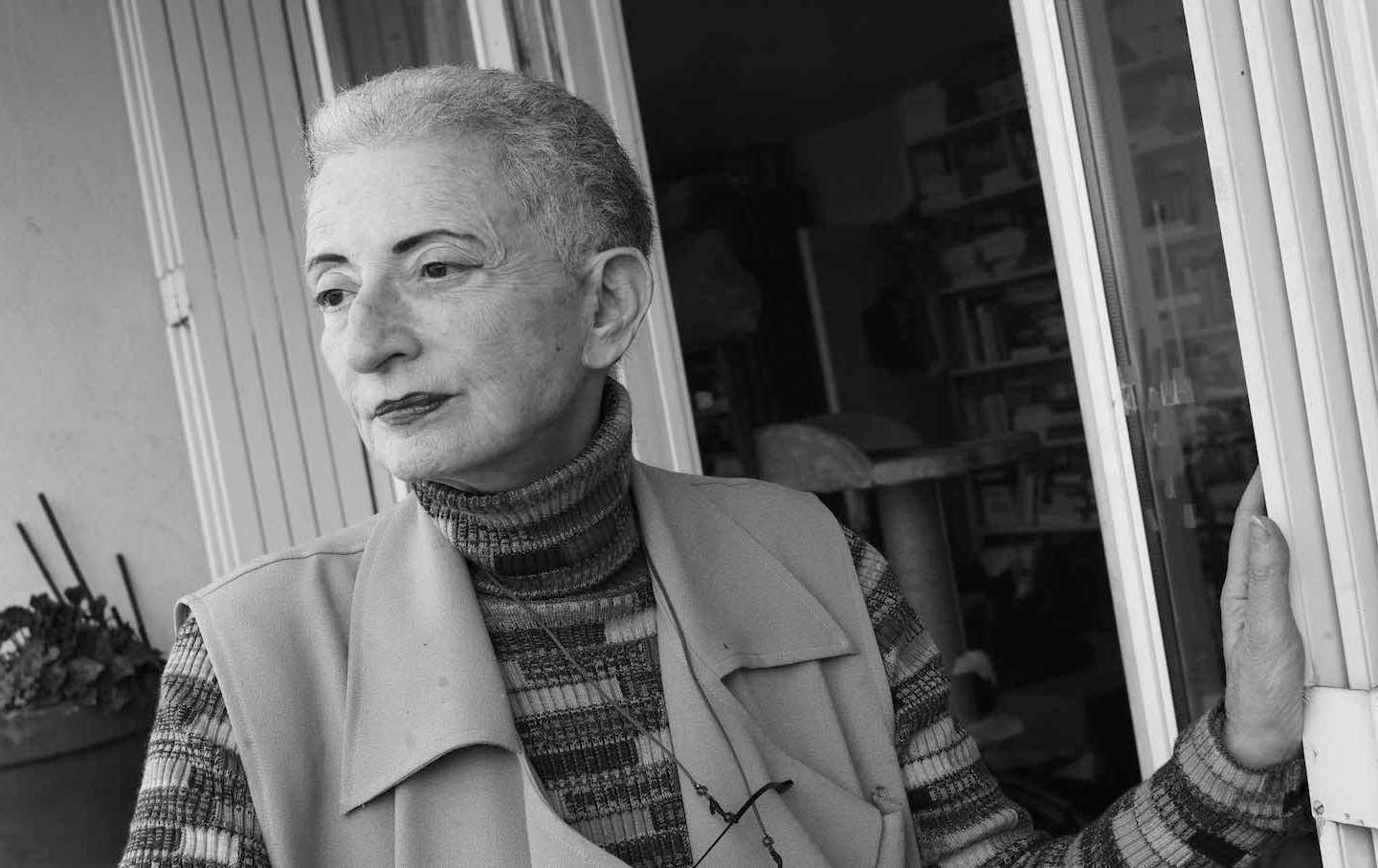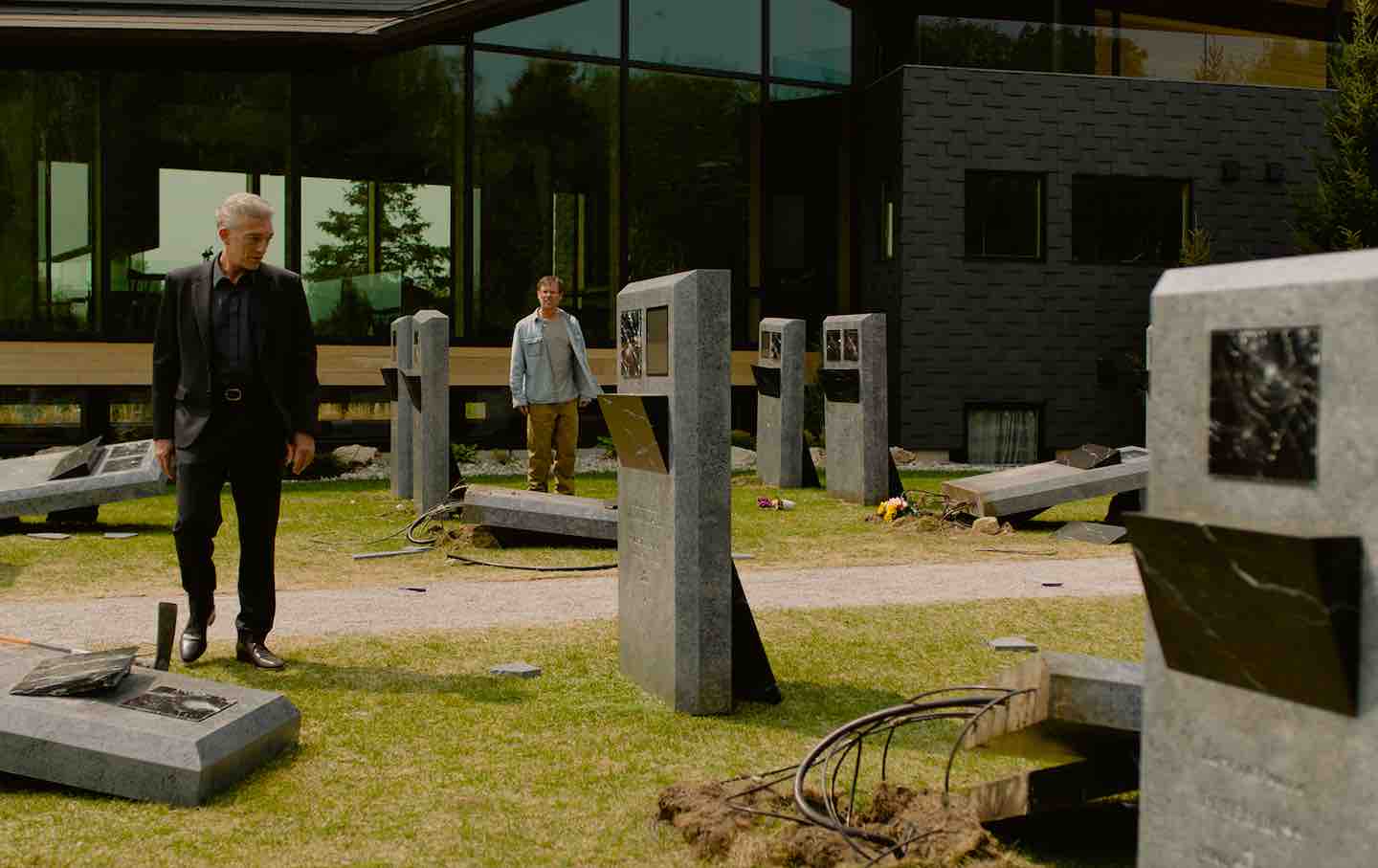Hélène Cixous, a Poet Among Theorists
In Well-Kept Ruins, a key example of her late style, a hybrid and dreamlike form of social theory comes into focus.

Hélène Cixous has increasingly come to regard herself as a poet rather than a social theorist. She has spoken of how she “could never have ventured onto the scene of political combat, which, nonetheless, is decisive for almost the totality of our destiny,” and also of her ambivalence about leaving the confrontation of “the monstrous blades of socio-political reality” to others:
You will tell me that I delegate. But one always delegates. The hardship is to be unable to do it. Others delegate to me the responsibility of keeping watch to ensure that a poetic imagination does not fall into dust.
The most appealing and irritating aspects of Cixous’s thought are evident in these statements. She possesses the poststructuralist’s conviction of différance—a coinage of Jacques Derrida, Cixous’s fast friend and a fellow Algerian Jew—that meaning is perpetually delegated, perpetually deferred. Many critics have quite reasonably interpreted this position as the timidity of an endlessly postponed political program. But Cixous also remembers one of the crucial aims, to my mind, of a liberatory politics: a life in which politics is not the horizon of action or meaning. This is a utopian impulse. And what is the stuff of poetry if not that?
Books in review
Well-Kept Ruins
Buy this bookWell-Kept Ruins finds Cixous, now entering her mid-80s, honing her late style. Skillfully interpreted by Cixous’s longtime translator, Beverley Bie Brahic, this most recent of her “memoir-novels” plays a series of variations on the major themes and techniques of Cixous’s career, which spans over 60 years: Her writing now transposes rather than composes. Half-glimpsed through the book’s oneiric vignettes, mammoth shadows wade: Kristallnacht, pied noir colonialism and the Algerian Revolution, the witch trials of medieval and early modern Europe, shades of Kafka and Lispector, psychoanalytic thought (and its mistakes and excesses), poststructuralism and poststructuralist feminism (and their mistakes and excesses), maternal legacies, private and collective loss, and many mortal fears.
Largely on the strength of her polarizing and widely read essay “The Laugh of the Medusa,” Cixous is best known in the Anglophone world as a theoretician associated with the capacious construct of French feminism (Simone de Beauvoir, Luce Irigaray, Monique Wittig, and Julia Kristeva are often classed under this head, despite a degree of ideological diversity). “The Laugh of the Medusa” is a manifesto that calls for woman to “write herself,” an insurgent practice that will return her to her “confiscated body.” Through this act, Cixous argues, the subject will enter her alienated record into history, asserting her due as a participant in the symbolic and political processes that relentlessly define themselves against her otherness. Cixous calls the method of this utopian curriculum écriture féminine, or “women’s writing,” which is meant to unsettle the “phallogocentric” modes of linear reason she understands as the inscription of patriarchy in language.
The essay features nascent versions of many of the same pleasures and frustrations that characterize her oeuvre across her career. Sometimes, its playful rhetoric possesses great force; at others, poetry and proposition get in each other’s way, which has led to fierce debates about the essay’s implications for different varieties of queer, trans, and feminist theory. Cixous’s prolific repertoire—more than 70 works of fiction, plays, and essay collections—has not been fully translated into English, and none of her translated writing has managed to eclipse the stature of “The Laugh of the Medusa,” which has performed an outsize part in shaping her reputation in the English-speaking world.
It’s a shame. From a distance of approximately 50 years, her most famous essay’s lushness can read as overripeness, its playfulness as archness, its provocations as blustering. Repetition has rendered many of its most striking positions commonplace, many of its most daring hazards merely bad bets. But the same gambits that mark “The Laugh of the Medusa” as a compelling, if flawed, snapshot of poststructuralist feminism in the 1970s modulate in unexpected ways in Cixous’s poetry, theatrical, and hybrid works.
Familiar from her early writing, the dreamlike switchbacks in scene and rhetoric remain in Well-Kept Ruins, which can be disorienting. But, tonally, the book reads as elegy, far removed from the polemic of “Laugh.” To take Cixous’s late style on its own terms is to read her as a poet meditating on the practice of three arts: losing (cities, people, the intangible legacies of memory), escaping (oppression, danger, the weight of history, life itself), and saving (whatever you can along the way). All these are the business of elegy, understood as the poetic practice of mourning. The philosopher Theodor Adorno thought of the late style of an artist as “showing more traces of history than of growth.” Late style always possesses a whiff of elegy, though “elegiac” doesn’t necessarily mean “nostalgic.” Cixous’s late style isn’t nostalgic, but unlike her early style, with its urgent advocacy of écriture féminine against patriarchy, it concerns itself far more with history and memory than with futurity and growth. It memorializes; it comes to terms; it mulls the worth of pacing old ground and leaves the breaking of new ground to others. Cixous’s collagist sensibility may be recognizable from her “Laugh of the Medusa” days, but while that essay makes tenacious demands on the immediate present, Well-Kept Ruins turns inward, toward the personal sense of a present wonderfully and terribly ruptured by the past.
This is weighty substance, but Cixous’s touch is lighter than it was—the bite of the early work has given way to a sadder, quieter form of comedy. The book begins with one of comedy’s ur-questions: “Where are we off to?” The answers are various: to Troy in the guise of Priam’s stenographer; to watch Johannes Kepler testify that his mother, whom he finds unpleasant, is not a witch; down the Hexengang, the Witches Road, to the Bocksturm (now a museum), where victims of the witch hunts were confined before drowning; and to its sequel in Barberousse, a prison in Algiers where Cixous’s beloved mother, Eve, a midwife accused of being an abortionist, was briefly incarcerated; to Osnabrück, the German town where Eve was born before she fled to Oran, Algeria. The narrative of Eve’s peripatetic life entwines with reflections on the life of Osnabrück, which Cixous knows primarily through her mother’s youthful memories.
For Cixous, Osnabrück assumes a mythic status—hence her allusions throughout to Troy and Pompeii. The town is a feast for ghosts, where “one time feeds on another.” Although “no one will ever return to Osnabrück,” Osnabrück often comes back from the underworld in Cixous’s oeuvre: Osnabrück Station to Jerusalem (2016), Eve Escapes (2009), and Osnabrück (1999), to name three. Well-Kept Ruins mixes the town’s gruesome history—women persecuted as witches and Nazi-era atrocities—with workaday cruelties and indignities. And then there are sweeter moments: of intimacy, multigenerational jokes, wistful reveries in which the dead speak with the authority of memory.
Cixous invents scenarios in the life of Osnabrück as a way of staying in touch with the silences of the historical record, which are both a loss and a license for invention. A resident of the city, Artur Baruth (“totally fictional,” though “recorded in the Osnabrück archives”) becomes, for Cixous, a literary character, the kind of “modestly tragic being…you find…in Dostoevsky and Chekhov…the emblem of the anguished and paradoxical theme; no-one-will-ever-know-his-story.” Baruth, as Cixous imagines him, materializes mustache-first, dreaming of translating Baudelaire into Hebrew. She associates him with Osnabrück’s synagogue, built in 1906 and burned on Kristallnacht in November 1938. Cixous envisions the building’s “rib cage, charred naturally,” and for a moment restores the synagogue to itself, a “tall, proud building with white sides, well-illuminated.” The effect is like a gag from silent cinema, where they run the film backward so that feasts revert to recipes and drunken sailors un-drown themselves—but, of course, what’s done is done.
The synagogue—what’s left of it—becomes Cixous’s central metaphor, the “well-kept ruins” that seem to occupy the crossroads of every one of the memoir-novel’s forking paths. When she visits Osnabrück in 2018, she finds the memorial where it once stood, a “wire mesh of tall cage tightly-packed with blond stones,” flanked by “two clean, well-buffed engraved copper tablets.” What’s left is merely this heap of stones in their mesh enclosure, “like hens, the well-kept ruins in their coop of rubble.” The analogy between Osnabrück’s synagogue and Osnabrück’s Jews is inevitable: “reduced to rubble in the metallic netting not one can escape”—though Cixous’s mother, Eve, implausibly, did. Cixous’s son remarks that the monument is “something you might see in a garden…. It requires an explanation if you don’t know what it is.” Osnabrück’s memorial, she writes, “hid[es] [the town’s] carceral nature under its well-kept, even elegant exterior,” a frightening disingenuousness.
Cixous doesn’t connect the monument’s blank tidiness to fascist aesthetics outright, although the suggestion is there. What strikes her more profoundly seems to be the naïveté of this orderly summation of atrocity—it doesn’t know its own duplicity. Imagine believing what the captive stones seem to promise: that the violent past can simply be put in its place, once a place is made for it, cleanly severed from the rest of the business of living. The innocence of this idea would be almost touching were it not, in itself, a defense against the recognition that ruin is ruin, even when it’s also something else. As if history could be lived with! In actuality, it is only lived until it is not.
Popular
“swipe left below to view more authors”Swipe →Simone de Beauvoir, Cixous’s intellectual predecessor, though a very different kind of thinker in many respects, ends her autobiography, The Force of Circumstance, with a cri de coeur against the evaporation of the archives of memory we carry within us. Beauvoir calls these intangibles “things that make no honey”:
the Opera of Peking, the arena of Huelva, the candomblé in Bahia, the dunes of El-Oued, Wabansia Avenue, the dawns in Provence, Tiryns, Castro talking to five thousand Cubans, a sulphur sky over a sea of clouds, the purple holly, the white nights of Leningrad, the bells of the Liberation, an orange moon over Piraeus, a red sun rising over the desert, Torcello, Rome, all the things I’ve talked about, others I have left unspoken—there is no place where it will all live again.
Well-Kept Ruins makes a rueful compromise with the delicacy of amassed experience as Beauvoir describes it, with the sum of encounters that can only persist, in their totality, in the equally delicate enterprise of a single life. “I am becoming Mama’s suitcase,” Cixous exclaims as she concludes, “I need to fit it all into a book.” She’s thinking of her mother’s escape artistry in the face of catastrophe. The open suitcase and its cargo of precious intangibles has to stand in for everything that’s lost or going to be. Even the most autobiographical writing merely approximates a life full of ephemera. But, like a book, a suitcase can be filled with what’s essential and carried with you and passed on to others. Significantly, Cixous leaves her suitcase—meaning the book and what she has to offer as a writer—open. “I’m not the one who closes it,” she says, refusing, with good humor, to cede the “things that make no honey” to forgetting, at least not yet. It’s the kind of final gesture a poet would make.
Hold the powerful to account by supporting The Nation
The chaos and cruelty of the Trump administration reaches new lows each week.
Trump’s catastrophic “Liberation Day” has wreaked havoc on the world economy and set up yet another constitutional crisis at home. Plainclothes officers continue to abduct university students off the streets. So-called “enemy aliens” are flown abroad to a mega prison against the orders of the courts. And Signalgate promises to be the first of many incompetence scandals that expose the brutal violence at the core of the American empire.
At a time when elite universities, powerful law firms, and influential media outlets are capitulating to Trump’s intimidation, The Nation is more determined than ever before to hold the powerful to account.
In just the last month, we’ve published reporting on how Trump outsources his mass deportation agenda to other countries, exposed the administration’s appeal to obscure laws to carry out its repressive agenda, and amplified the voices of brave student activists targeted by universities.
We also continue to tell the stories of those who fight back against Trump and Musk, whether on the streets in growing protest movements, in town halls across the country, or in critical state elections—like Wisconsin’s recent state Supreme Court race—that provide a model for resisting Trumpism and prove that Musk can’t buy our democracy.
This is the journalism that matters in 2025. But we can’t do this without you. As a reader-supported publication, we rely on the support of generous donors. Please, help make our essential independent journalism possible with a donation today.
In solidarity,
The Editors
The Nation








